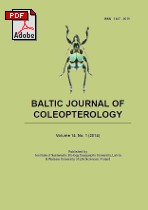Nutrition ofOpatrum sabulosum(Coleoptera, Tenebrionidae) when fed on leaves of trees, shrubs and liana plants in the conditions of a laboratory experiment
Main Article Content
Keywords
:
Opatrum sabulosum; Tenebrionidae; food preferences; laboratory experiments; phytophagous insects
Abstract
This paper provides data of the analysis of the role of the dried leaves of 33 plant species (21 trees, 10 shrubs and 2 perennial liana plants) in the nutrition of Opatrum sabulosum (L.), a mass pest of field crops in the Eurasia steppe zone. Imagines of darkling beetles were maintained during 5 days (n = 32) in plastic containers with an equal weight of leaves of each plant species offered. None of three parameters under study (mass of food consumed, change in body weight, faecal mass) taken individually can be sufficient for evaluation of the metabolic value of each trophic object for the beetle. To evaluate the metabolic value of each plant species for the beetle a normative rating was assigned for each of the above three parameters. The plants which provided the maximum metabolic value for O. sabulosum were Mîrus nigra L., Ulmus laevis Pall., Armeniaca vulgaris Lam., Tilia cordata Mill., Prunus cerasifera Ehrh. and Quercus robur L. The metabolic value of Cornus mas L., Acer platanoides L., Prunus nigra L., P. spinosa L., Ribes nigrum L. was less pronounced. The metabolic value of Vitis vinifera L., Crataegus monogyna Jacq., Rhamnus cathartica L., Acer negundo L. and Armeniaca vulgaris Lam. featured medium intensity. Practically no metabolic value was found for Malus domestica Borkh., Paeonia suffruticosa Andrews., Viburnum opulus L., Morus alba L., Sambucus nigra L., Caragana arborescens Lam., Salix alba L., Rubus idaeus L., Elaeagnus angustifolia L., Juglans regia L., Populus alba L. and Ulmus minor Mill.
Article Details
Statistics
Downloads
Download data is not yet available.
Recommend Articles
